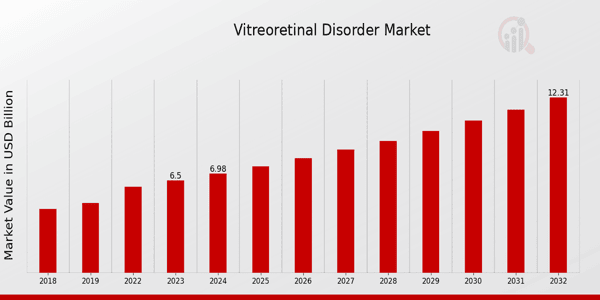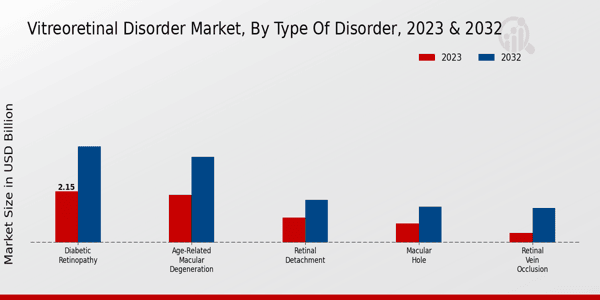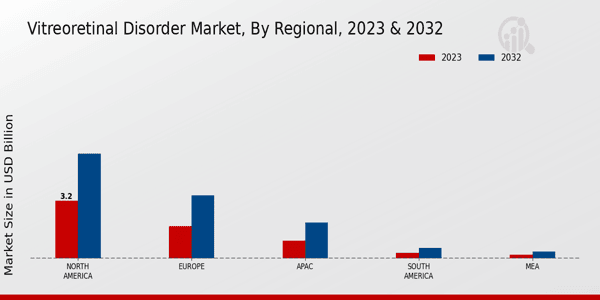Vitreoretinal Disorder Market Overview:
As per MRFR analysis, the Vitreoretinal Disorder Market Size was estimated at 7.50 (USD Billion) in 2024. The Vitreoretinal Disorder Market Industry is expected to grow from 8.05 (USD Billion) in 2025 to 15.22 (USD Billion) till 2034, at a CAGR (growth rate) is expected to be around 7.34% during the forecast period (2025 - 2034).
Key Vitreoretinal Disorder Market Trends Highlighted
The Vitreoretinal Disorder Market is in a period of remarkable growth due to a number of factors. The increased incidence of vitreoretinal diseases, most commonly age-related macular degeneration and diabetic retinopathy, has created a need for efficient treatments. Technological developments, which include surgical techniques and novel therapeutics, are improving the results of patients and the range of treatment options. Moreover, an increase in the number of older individuals who are more prone to eye disorders is also aiding in market growth. The increasing incidence of these disorders and awareness regarding their timely treatment are also important factors propelling the market.
This market has numerous opportunities which can be tapped by various stakeholders. The growing focus on personalized medicine creates opportunities to make targeted therapies based on individual patients. The advancement of telemedicine along with digital health adds a chance to improve clientele and accessibility to health care. In addition, the prospect of carrying out clinical trials for new therapeutic options creates opportunities for major progress in medicine. The partnership of biotech companies with research organizations will help develop modern medicines, and thus, it is the right time to invest in research and development.
Over the last few years, a repeated pattern of adopting new techniques that have minimal invasiveness has been witnessed and is preferred by both patients and healthcare providers. Such a change is influenced by the expectations of patients for less recovery time and lower chances of surgical invasiveness. Furthermore, with the use of AI and machine learning-enabled devices, the diagnosis of vitreoretinal phakomatosis is rapidly changing in terms of how vitreoretinal specialists diagnose and manage the condition.
Naturally, as more people are made aware of and educated about such newer technologies, their adoption will lead to further developments within the region. Accordingly, changes in the dynamics of the market for the management of vitreoretinal disorders are expected where the emphasis is on more novel and efficient approaches to the management of the conditions.

Source: Primary Research, Secondary Research, MRFR Database and Analyst Review
Vitreoretinal Disorder Market Drivers
Increasing Prevalence of Vitreoretinal Disorders
The rise in the global population, along with an increasing aging demographic, has led to a higher incidence of vitreoretinal disorders. These disorders, which include conditions such as diabetic retinopathy, age-related macular degeneration, and retinal detachment, are becoming more common. Health experts indicate that as the aging population grows, the number of individuals suffering from various eye-related conditions will continue to increase.
The Vitreoretinal Disorder Market Industry recognizes that this uptick in prevalence directly correlates with demand for innovative treatment options, consultation, and surgical procedures aimed at addressing these complex disorders. The growing awareness surrounding eye health and the proactive approach some governments and health organizations are taking to screen for these conditions further drive the market. Additionally, advancements in imaging technologies and diagnostic procedures have facilitated earlier and more accurate detection of vitreoretinal disorders, enhancing patient outcomes and increasing the patient population that may require specialized treatments.
As healthcare evolves, it is expected that the infrastructure to support diagnosing and treating these conditions will expand, leading to sustained growth in this sector.
Technological Advancements in Treatment Methods
The Vitreoretinal Disorder Market Industry is witnessing significant technological advancements in treatment methods, which is a major driver of market growth. Innovations such as minimally invasive surgical techniques, improved laser treatment options, and enhanced ocular implants have transformed traditional approaches, enabling better patient outcomes. These advancements not only increase the efficacy of treatments but also minimize recovery times for patients, leading to an overall growth in patient satisfaction and a rise in surgical procedures performed.Furthermore, the introduction of novel pharmaceutical therapies is creating new possibilities for treatment, expanding the range of options available for healthcare professionals to combat vitreoretinal disorders.
Rising Investment in Healthcare Infrastructure
Another key driver for the Vitreoretinal Disorder Market Industry is the rising investment in healthcare infrastructure, particularly in developing regions where access to eye care services has traditionally been limited. Governments and private sector investors are recognizing the importance of adequate healthcare facilities and are therefore increasing their allocation of funds to improve healthcare services related to vision care.
This includes the establishment and expansion of specialized eye care centers and the training of healthcare professionals in advanced vitreoretinal techniques.As more facilities are built and more services become available, it is expected that patients will have greater access to vitrectomy procedures and other interventions, driving market growth.
Vitreoretinal Disorder Market Segment Insights:
Vitreoretinal Disorder Market Type of Disorder Insights
The Vitreoretinal Disorder Market showcases significant growth within the Type of Disorder segment, with a comprehensive valuation reaching approximately 6.5 USD Billion in 2023 and projected to expand over the coming years. Among the various disorders represented, Diabetic Retinopathy stands out as the most prominent, holding a substantial market value of 2.15 USD Billion in 2023 and is expected to grow to 4.05 USD Billion by 2032. This disorder caters predominantly to the growing diabetic population, emphasizing its crucial role in the vitreoretinal market.
Age-related Macular Degeneration follows closely, valued at 2.0 USD Billion in 2023 and with expected growth to 3.6 USD Billion by 2032, marking it as a significant contributor to the market due to increasing aging populations globally. Another notable disorder in the market is Retinal Detachment, initially valued at 1.05 USD Billion in 2023, which is projected to rise to 1.8 USD Billion by 2032, highlighting its relevance among ocular diseases demanding immediate attention. Meanwhile, Macular Hole, while smaller in comparison, holds a valuation of 0.8 USD Billion in 2023, forecasted to grow to 1.5 USD Billion by 2032.
Lastly, Retinal Vein Occlusion, the least valued at 0.4 USD Billion in 2023 but expected to experience significant upward movement to 1.45 USD Billion by 2032, reflects growing awareness and diagnosis in ocular healthcare. The segmentation within the Vitreoretinal Disorder Market not only illustrates the diverse nature of these disorders but also indicates the vital part each type plays in the overall landscape. Factors such as aging demographics, lifestyle choices, and enhanced diagnostic techniques are key drivers propelling the market forward.
Concurrently, challenges like treatment accessibility and rising healthcare costs are factors that pose hindrances to this growth. Nevertheless, the potential for innovative treatment options creates vast opportunities within the Vitreoretinal Disorder Market revenue, firmly establishing it as a pivotal domain within the larger healthcare industry. As the market grows, data-driven insights specific to each disorder provide crucial information guiding research and development efforts, ensuring that advancements in clinical solutions align with the needs of a diverse patient population.”

Source: Primary Research, Secondary Research, MRFR Database and Analyst Review
Vitreoretinal Disorder Market Treatment Type Insights
The Vitreoretinal Disorder Market is projected to be valued at 6.5 billion USD in 2023, with significant growth anticipated in the coming years. Within this market, the Treatment Type segment plays a crucial role in addressing various vitreoretinal disorders through diverse approaches. Surgical Treatments are vital for conditions that require invasive intervention, ensuring immediate correction and improving patient outcomes. Therapeutic Treatments focus on managing symptoms and enhancing the quality of life, indicating the importance of non-invasive care.
Pharmaceutical Treatments represent a substantial portion of market interactions, serving as essential solutions for long-term management and disease modification. Laser Treatments are noteworthy for their minimal invasiveness and efficacy in treatment, highlighting their growing role in ocular health. The trends towards personalized medicine and advancing technologies are driving these segments, while challenges such as high costs and accessibility remain. Nonetheless, the opportunities for innovations in these treatment areas signify a dynamic landscape within the Global Vitreoretinal Disorder Market, emphasizing the necessity for ongoing research and development in this vital healthcare field.
Vitreoretinal Disorder Market End User Insights
In 2023, the Vitreoretinal Disorder Market was valued at 6.5 USD Billion, showcasing significant enhancement in the healthcare sector focused on eye disorders. The End User segmentation plays a crucial role, particularly highlighting the importance of hospitals, eye clinics, and ambulatory surgical centers in the treatment of vitreoretinal diseases. Hospitals typically provide comprehensive resources and specialized medical professionals, leading to a major share in this market sector. Eye clinics are equally vital as they cater specifically to ocular health, often focusing on preventive measures and early diagnosis, which are essential for the effective management of retinal conditions.
Ambulatory surgical centers are gaining traction due to their efficiency and convenience, allowing patients to receive care with reduced downtime. The growth trajectory for this segment is reinforced by increasing incidences of retinal disorders, rising awareness regarding eye health, and advancements in technology that enhance treatment efficacy. Overall, each of these end user categories contributes uniquely to the landscape of the Global Vitreoretinal Disorder Market, facilitating accessible and specialized care for patients.
Vitreoretinal Disorder Market Drug Class Insights
The Global Vitreoretinal Disorder Market, projected to be valued at 6.5 USD Billion in 2023, showcases significant growth potential within its Drug Class segment. This segment includes various pivotal therapy options such as Anti-VEGF, Corticosteroids, Laser Treatment Medications, and Surgical Instruments. Anti-VEGF therapies, which target vascular endothelial growth factors, play a crucial role in treating conditions like age-related macular degeneration and diabetic retinopathy, reflecting their importance in the market due to their widespread usage.
Corticosteroids also hold a significant share, offering anti-inflammatory benefits that are essential for managing vitreoretinal disorders effectively. Moreover, Laser Treatment Medications provide minimally invasive options, enhancing patient comfort and recovery time, which is increasingly preferred in clinical settings. Surgical Instruments are integral to the market, ensuring precision in therapeutic interventions, thereby streamlining treatment processes.
The growing patient pool and persistent prevalence of vitreoretinal disorders drive market growth, while ongoing advancements in treatment technologies present numerous opportunities.Overall, the Drug Class segment embodies a vital component of the Global Vitreoretinal Disorder Market, accounting for a substantial portion of the overall market revenue and reflecting robust trends in therapeutic innovation and patient care advancements.
Vitreoretinal Disorder Market Regional Insights
The Vitreoretinal Disorder Market showcases a diverse regional segmentation, with North America holding the majority with a market value of 3.2 USD Billion in 2023 and projected to grow to 5.8 USD Billion by 2032. This significant market position is driven by advanced healthcare infrastructure and the increased prevalence of vitreoretinal disorders in this region. Following North America, Europe stands as the second largest market, valued at 1.8 USD Billion in 2023 and expected to reach 3.5 USD Billion by 2032, supported by strong governmental healthcare initiatives and innovative treatment methodologies.
The APAC region is gradually establishing its significance, valued at 1.0 USD Billion in 2023, anticipated to rise to 2.0 USD Billion by 2032, reflecting rising awareness and access to healthcare facilities. On a smaller scale, South America and MEA represent emerging markets with valuations of 0.3 USD Billion and 0.2 USD Billion, respectively, in 2023, highlighting considerable growth opportunities. The overall increase across these regions indicates a notable upward trend in the Vitreoretinal Disorder Market revenue, driven by an aging population and the rising incidence of retinal diseases, presenting new possibilities for industry participants.

Source: Primary Research, Secondary Research, MRFR Database and Analyst Review
Vitreoretinal Disorder Market Key Players and Competitive Insights:
The competitive landscape of the Vitreoretinal Disorder Market is characterized by a dynamic interplay of innovation, strategic partnerships, and comprehensive product portfolios aimed at addressing a range of retinal conditions. This market involves a variety of pharmaceutical and biotechnology companies that focus on developing novel therapies and treatment options for disorders such as diabetic retinopathy, age-related macular degeneration, and retinal vein occlusion.
Players in this market continuously seek to enhance their offerings and maintain competitive advantage through rigorous research and development, collaborations, and expanding their geographic reach. The increasing prevalence of retinal disorders globally elevates the competitive stakes, encouraging companies to invest in cutting-edge technologies and novel drug deliveries to better meet patient needs and improve clinical outcomes.
Bausch Health Companies has established a significant presence in the Global Vitreoretinal Disorder Market, drawing on its strong legacy and commitment to innovation in eye health. The company benefits from a comprehensive portfolio of products that cater specifically to vitreoretinal conditions, bolstered by ongoing research and clinical trials aimed at enhancing treatment efficacy. Bausch Health Companies emphasizes its ability to deliver high-quality therapies and has forged strategic alliances that broaden its reach and enhance its product offerings.
The integration of advanced technologies in its development processes has allowed the company to rapidly adapt to changing market dynamics and patient needs, solidifying its standing in the competitive landscape. Furthermore, Bausch Health Companies' focus on patient care and education serves to strengthen its brand loyalty among healthcare professionals and patients alike.
Merck Sharp and Dohme has also carved out a noteworthy position in the Vitreoretinal Disorder Market by leveraging its robust research capabilities and extensive product portfolio. The company is recognized for its dedication to advancing treatment options for retinal conditions through a focused approach to medical science and technology. Merck Sharp and Dohme invest significantly in clinical research, which has resulted in the development of innovative therapies that address critical unmet needs in retinal disease treatment.
The firm's collaborative initiatives and partnerships with various stakeholders in healthcare facilitate the exploration of new solutions that improve patient outcomes. By prioritizing the discovery and development of next-generation therapies, Merck Sharp and Dohme continue to play a pivotal role in shaping the future of vitreoretinal care on a global scale, making a positive impact within the market amidst evolving challenges.
Key Companies in the Vitreoretinal Disorder Market Include:
- Regeneron Pharmaceuticals
Vitreoretinal Disorder Market Industry Developments
Recent developments in the Vitreoretinal Disorder Market have underscored a robust interest in innovative treatments and expansion strategies among key players. Bausch Health Companies and Novartis have enhanced their portfolios through the introduction of new therapies aimed at retinal diseases. Merck Sharp and Dohme continue to invest in research and development, focusing on advanced drug delivery systems, while Amgen and Roche are involved in clinical trials for novel biologics targeting age-related macular degeneration and diabetic retinopathy. Santen Pharmaceutical has been actively pursuing partnerships to broaden its therapeutic reach.
Alcon has achieved notable growth by launching next-generation surgical equipment, bolstering its position in the market. The ongoing trend of mergers and acquisitions is evident as companies like Genentech and Regeneron Pharmaceuticals seek to expand their therapeutic offerings and improve patient outcomes. Hoya Corporation's acquisition of specialized medical technology has been a significant strategic move noted recently. Overall, these advancements reflect a dynamic market landscape with increasing investment in innovative solutions, which is expected to positively impact the valuation of companies involved, driving growth and development in treating vitreoretinal disorders.
Vitreoretinal Disorder Market Segmentation Insights
Vitreoretinal Disorder Market Type of Disorder Outlook
- Age-related Macular Degeneration
Vitreoretinal Disorder Market Treatment Type Outlook
- Pharmaceutical Treatments
Vitreoretinal Disorder Market End User Outlook
- Ambulatory Surgical Centers
Vitreoretinal Disorder Market Drug Class Outlook
- Laser Treatment Medications
Vitreoretinal Disorder Market Regional Outlook
| Report Attribute/Metric |
Details |
|
Market Size 2024
|
7.50 (USD Billion)
|
|
Market Size 2025
|
8.05 (USD Billion)
|
|
Market Size 2034
|
15.22 (USD Billion)
|
|
Compound Annual Growth Rate (CAGR)
|
7.34 % (2025 - 2034)
|
|
Report Coverage
|
Revenue Forecast, Competitive Landscape, Growth Factors, and Trends
|
|
Base Year
|
2024
|
|
Market Forecast Period
|
2025 - 2034
|
|
Historical Data
|
2020 - 2024
|
| Market Forecast Units |
USD Billion |
| Key Companies Profiled |
Bausch Health Companies, Merck Sharp and Dohme, Novartis, Santen Pharmaceutical, Alcon, Amgen, Hoya Corporation, Optos, Vifor Pharma, Kowa Company, Roche, Carl Zeiss AG, Regeneron Pharmaceuticals, Genentech, Eyenovia |
| Segments Covered |
Type of Disorder, Treatment Type, End User, Drug Class, Regional |
| Key Market Opportunities |
Increasing prevalence of retinal diseases, Advances in minimally invasive surgeries, Growth in telemedicine solutions, Rising investment in ocular research, Expanding geriatric population requiring treatment |
| Key Market Dynamics |
increasing prevalence of eye diseases, advancements in surgical techniques, rising geriatric population, growing healthcare expenditure, demand for minimally invasive procedures |
| Countries Covered |
North America, Europe, APAC, South America, MEA |
Frequently Asked Questions (FAQ):
The Vitreoretinal Disorder Market is expected to be valued at 12.3 billion USD by 2034.
The market is expected to grow at a CAGR of 7.34% from 2025 to 2034
North America is projected to hold the dominant market share, valued at 5.8 billion USD in 2034.
The market value for Diabetic Retinopathy was 2.15 billion USD in 2023.
The market for Age-related Macular Degeneration is expected to grow to 3.6 billion USD by 2034.
The market size for Retinal Vein Occlusion is expected to reach 1.45 billion USD by 2034.
Some key players in the market include Bausch Health Companies, Merck Sharp ,Dohme, and Novartis.
The APAC region is expected to reach a market value of 2.0 billion USD by 2032.
The market value for Retinal Detachment was 1.05 billion USD in 2023.
Challenges such as high treatment costs and limited access to advanced healthcare facilities may impact market growth.

















